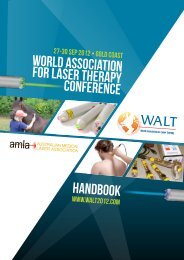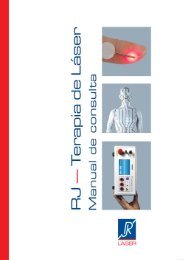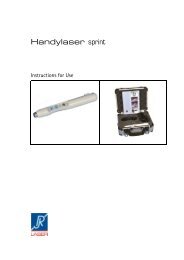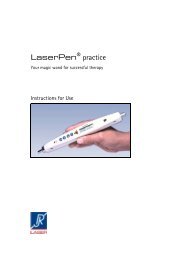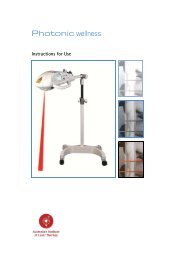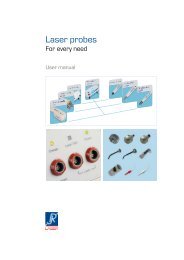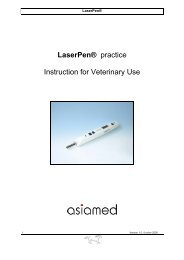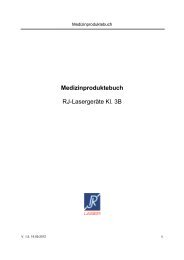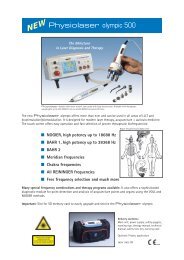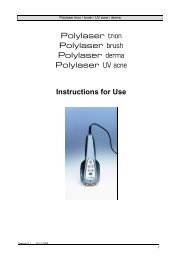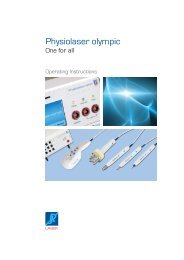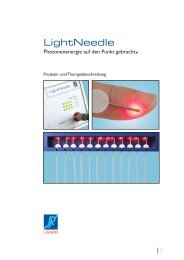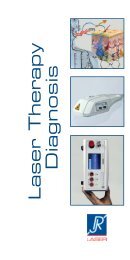LightNeedle - RJ Laser
LightNeedle - RJ Laser
LightNeedle - RJ Laser
Create successful ePaper yourself
Turn your PDF publications into a flip-book with our unique Google optimized e-Paper software.
38<br />
that is shining on the skin does not create any acupuncturelike<br />
reaction nor does it interact with peripheral sensory<br />
nerves. The pleasant warmth that we feel on the skin during<br />
a summer day does not come from the visible light of<br />
the sun. How can laser light stimulate acupoints? If one<br />
pricks a metal needle in the skin, the patient often feels pain.<br />
Is that physical stimulation an essential requirement for efficient<br />
acupuncture?<br />
2) Which parameter and properties are important in laser<br />
acupuncture that determine the therapeutic efficacy?<br />
3) Is it dangerous to stimulate acupuncture points by laser<br />
irradiation? Are there any risks or side effects?<br />
4) Is laser acupuncture comparable to the traditional metal<br />
needle acupuncture regarding its therapeutic efficacy?<br />
5) What are the limits and challenges of laserneedle stimulation.<br />
These 5 topics are addressed in this paper. One of the<br />
practical outcomes of our previous research work was a new<br />
medical instrument, the “laserneedle.” 1 We are aware that<br />
the term laserneedle is somewhat misleading; it suggests that<br />
these instruments hurt the skin. This is not true; laserneedles<br />
are non-invasive instruments that do not puncture the<br />
skin. They are brought in contact with the skin and can be<br />
fixed on the skin, but do not penetrate the skin. Therefore,<br />
acupuncture treatments with laserneedles are of non-invasive<br />
character and are free of the unpleasant metal needle<br />
pain sensations.<br />
HOW DOES LASERNEEDLE<br />
ACUPUNCTURE WORK?<br />
The mechanism of acupuncture analgesia has been studied<br />
extensively in the past 2 decades in Western countries. 2<br />
Studies using biomedical instruments have demonstrated the<br />
key role of the brain in acupuncture. 3–11 It was also found<br />
that the insertion of a metal needle into an acupuncture point<br />
leads to a release of different chemical substances like histamine,<br />
bradykinin, substance P, and ATP in the tissue at the<br />
acupuncture point. Due to the increased concentration of<br />
these substances, the peripheral nociceptors, which exist in<br />
great numbers at acupoints, seem to become depolarized. As<br />
SCHIKORA<br />
a consequence, rhythmic discharges occur in nociceptors and<br />
a cascade of electrical signals (action potentials) is generated<br />
and transmitted via afferent nerve fibres to the brain. Specific<br />
cortical areas like the pain-related cores of the hypothalamus<br />
and areas of the limbic system become activated. 3,12<br />
The following effect transduction from the central nervous<br />
system to the periphery, accompanied by a release of �-endorphins<br />
and other opiogen or non-opiogen neurotransmitters,<br />
uses efferent signal paths. This rather short description of the<br />
basic mechanism of acupuncture analgesia shall illustrate the<br />
essential point. That means that acupuncture effects are based<br />
on rhythmic discharges of nociceptors and are not based on<br />
the needle pain. As a consequence, painless acupuncture<br />
should be possible, provided that the rhythmic discharges of<br />
nociceptors can be induced in a non-invasive, non-traumatic<br />
way. In this context, the question arises: can we use laser irradiation<br />
for the induction of discharges in peripheral nociceptors?<br />
The answer is not as simple as it seems. Visible light<br />
does not interact with peripheral nerves; we do not feel pain<br />
during light illumination of the skin. How can nociceptors<br />
discharges be generated by light if there is no interaction? To<br />
investigate this problem, we did cell research studies, using<br />
mast cells selected from human connective tissue. 13 Single<br />
mast cells were isolated by a patch-clamp technique and illuminated<br />
with the red radiation of a laserneedle. Figure 1<br />
demonstrates the effect of the laserneedle-radiation.<br />
A few minutes after laserneedle illumination, the mast<br />
cell degranulates, releasing histamine. Conversly, a mast cell<br />
that is not illuminated does not show any effects under the<br />
same experimental conditions. This suggests that the irradiation<br />
of red laser light, emitted by a laserneedle, leads to a<br />
release of histamine in the connective tissue at the acupoint.<br />
When the histamine concentration increases, the nociceptors<br />
again become depolarized and rhythmic discharges may initiate.<br />
This may be the basic mechanism of laser acupuncture<br />
and it suggests the important role of connective tissue<br />
in acupuncture. The stimulation is of indirect character; the<br />
light does not directly influence the peripheral nociceptors,<br />
but probably influences indirectly the alteration of the histamine<br />
concentration in the surrounding connective tissue.<br />
We have found that the release of histamine from the connective<br />
tissue mast cells occurs only when a critical value<br />
FIG. 1. Degranulation of a single human mast cell of connective tissue, irradiated 60 s by a laserneedle, in-vitro isolated by a patchclamp<br />
technique (a: before irradiation; b: after 10 minutes; c: after 25 minutes).



